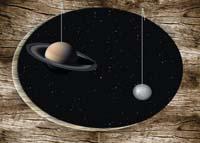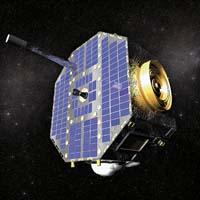Text written in Basque and translated automatically by
Elia without any subsequent editing.
SEE ORIGINAL
The hidden face of the Moon
2008/04/01
Azkargorta Aretxabala, Jon - Fisikan doktorea. Bilboko Ingeniaritza Goi Eskolako irakasle eta ikertzaileaEHU
Iturria:
Elhuyar aldizkaria
The time it takes the Earth to form an orbit around the Sun is one year. The time it takes the Earth to turn around its axis, instead, is called day. In a year there are about 365 days. That is well known. But has it always been so? For its part, the Moon forms an orbit around the Earth once a month, and also rotates on its axis once a month (27.32 days). The two are equal! News Consequently, the Moon always shows us the same face. If we look with some attention to the sky, we will always see that difference: sometimes an illuminated and dark part... but always the same. However, the Sun illuminates or "sees" equally on both sides of the Moon, but we do not: always looking towards us is the same side of the Moon, both when it is illuminated and when not.
The hidden face of the Moon
01/04/2008 | Azkargorta Aretxabala, Jon | Doctor of Physics
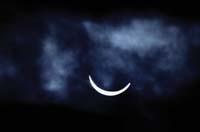
(Photo: Archive)
The Moon existed before man emerged, and has always fascinated us, for thousands of years, but we have never seen its back.
In 1959 the Soviets sent the Luna-3 mission and managed to photograph the back… 50 years have not yet been fulfilled [1]. As we have said, from Earth you can never see that back of the Moon, if not in a photo.
In principle there is no physical relationship between the rotation of a body and the duration of an orbit. So why does the duration of a 'day' of the Moon coincide with the duration of a 'month'? Is it chance? The whim of the Moon?
There is a reason and it has to do with the tides. We know that on Earth the sea goes up and down twice a day. The reason is explained in depth in the article [2], but here I will make a brief summary:

To the left, part of the Moon we see. Next door, what we do not see, that is, what hides, look at him with tranquility and tranquility, because you will never see him in the night sky.
ANDÉN
Just as the Earth attracts the Moon, the Moon also attracts the Earth. But due to the size of the Earth, the area near the Moon feels greater attraction than the central one and the sea approaches the Moon. On the other hand, the remote area of the Moon feels less attracted than the central and the sea away from the Moon. As a result, the Earth suffers a "deformation", with two sides of the fold (G) and two of the low tide (B) simultaneously on Earth (Figure 1).
To this we must add that the Earth rotates once a day, so we have two pleamares every day and two bajamares every day.
Just as the Moon creates tides on Earth, the Earth also creates them on the Moon. Okay! On the Moon there is no sea but solid bodies deform as much as liquids, but deform as a rubber ball. The deformation of the solid earth produced by the Moon is a few centimeters and we do not realize it, but seismographs, for example, detect very well the tides of earth. For on the Moon there are also solid tides and the ground rises and falls every time the Moon gets upset, that is, twice a month.
How the Earth affects the rotation of the Moon

The Earth Deformed by the Moon
deformation is greatly increased to be highlighted graphically. Also in the graphics of the following pages
(Photo: G. Roa)
If the Moon were fully elastic, it would respond 'immediately' to Earth's attraction and its 'deformation' would be aligned with Earth, as shown in Figure 2A. However, throughout the universe there is no fully elastic material, and the internal friction and inertia of solid material cause the Moon's response to occur later, i.e. with a delay, as in Figure 2B.
The conclusion is spectacular (Figure 3): When the Earth attracts the Moon, the force of side A tends to turn the Moon towards the clock hands, while the force of side B turns the Moon against the clock hands. The force of side A is somewhat greater, because it is closer to the Earth, which causes the Earth to turn the Moon towards the clockwise, or what is the same, slows the rotation of the Moon.
How long does this cushioning last? For the rotation of the Moon has been slowly and for thousands of years, until today it reaches a position of equilibrium, that is, a symmetrical position, where point A and point B are located in the same direction of the Earth. Therefore, from Earth we only see zone A of the Moon, because the Earth has synchronized or "stopped" the rotation of the Moon for a long time.
Most of the natural satellites or 'moon' of the solar system, like our Moon, are synchronized; the satellites of Mars, Jupiter, Saturn, etc. have the same period of rotation and orbit around the planet [3].

The Moon deformed by the Earth. To the left it is shown that the Moon responds with a delay to the attraction of the Earth. To the right, forces that cause the synchronization of the Moon with the Earth.
G. Roa
The Sun also generates tidal forces that have made the rotations of Mercury and Venus not synchronized at all, but if they are rather dampened, they are closest. The rest of the planets are far away and the effect is weaker, but it exists.
How the Moon affects Earth's rotation
If the Earth has paralyzed the rotation of the Moon, it is logical to think that the Moon will have a similar effect on the Earth. It is true. The Earth does not always show the same difference to the Moon, that is, the Earth is not 'synchronized', but is slowing down.
Since the mass of the Earth is much larger than the mass of the Moon, more time will have to be spent until the Earth 'stops', but in that it is: The duration of a day on Earth was shorter in the past, that is, the Earth revolved faster.

The Moon always shows the same face to Earth, but the Earth does not show the Moon.
ESA
There are paleontological studies that have gone far in time and that demonstrate this result [5]: for example, coral fossils have rings or growth layers called ephitecas. As in tree trunks, each ring shows coral growth over a one-year cycle. More detailed studies have shown that within each layer there are other thinner layers: they are monthly layers, within which there are other even finer layers. The finest layers have been considered as indicators of daily growth. The number of thin layers has been counted within an annual layer of coral fossils from the Paleozoic Devonian era (400 million years ago): 400 rings. On the contrary, within the one-year ring of Garai Carbonífero's coral-fossil (300 million years) there are 380 layers. This means that the Earth revolved 400 times a year in the Devonian era and made 380 tours a year in the Charcoal. Everyone can make a small calculation and see that in the Devonian era the Earth day lasted about 22 hours and in the Carbonífera era about 23 hours. We know it currently lasts about 24 hours.
The same result has been proven with other methods, that is, the Earth is increasingly slowed down. In fact, with the accuracy of atomic clocks it has been shown that the duration of the day is increasing: 2.3 milliseconds per century [4].
Moving away
As shown in the previous section, the Moon exerts the same effect as the Earth on the Moon: cushion rotation. Figure 4 shows, on the left, the Earth and the forces of the Moon on Earth (A and B). These two forces are the ones that are stopping the rotation of the Earth, as mentioned in the previous section.

Like the Moon, the Moon slows down the rotation of the Earth. The following figure shows the forces that cause it.
G. Roa
On the other hand, the right part of the image shows the Moon and the forces that both parts of the Earth exert on the Moon (A' and B'), which are reactions of the previous, exactly the same but opposite.
Forces A' and B' that support the Moon have a component (and the principal) in the direction of the Earth, but have another component perpendicular to this direction. The force 'A' rises a little and the force 'B' drops, but the force 'A' is something greater because the Earth is closer than the B. Therefore, another consequence of the tidal forces is that the Moon has a tangential acceleration ( to t) or that it is increasing its speed. If speed is increased, the centrifugal force of your orbit also increases, causing an increase in the radius of the orbit. Thus, over the years, the Moon is moving away from Earth and its 'month' is getting longer.
Physicists say that energy is not produced or erased, that is, it is preserved, but it is changed from one type to another: If the rotation of Earth and Moon is slowing down, kinetic energy will lose, although this energy is becoming potential energy as the Moon and Earth move away.
In fact, the orbit of the Moon is not a circle or an ellipse, but gradually grows like a spiral. Exact measurements have shown that the Moon is moving almost four centimeters a year [6].
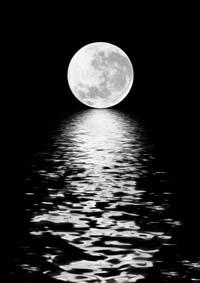
(Photo: Archive)
How long will this slowdown of Earth's rotation last? And how long will the Moon be away from Earth? It is estimated that the Moon will keep moving away until the current distance increases by sixty percent. By then the rotation of the Earth will be slowed down and the duration of the day will be the same as the month of the Moon, and both will be about fifty-five days [7] (the day of this phrase is the duration of the current day). At that time, the deformation of the Earth and that of the Moon will be symmetrical about the direction between the two, that is, the Earth, seen from the Moon, will always show the same face and keep the other in secret, but until this happens it will take billions of years.
How it came about, a mystery still
If instead of moving back in time, calculations show that two billion years ago the Earth-Moon distance was much smaller, several times longer than the Earth radius. This calculation raises an old question from scientists: What is the origin of the Moon?
Various theories have served to understand the origin of the Moon. A first theory says that the Moon and the Earth were two bodies and that the Moon separated from the Earth because the Earth revolved too quickly [8]. This theory explains why stones from the Moon and earth stones have a similar geological antiquity. The dating of the lunar stones showed that they were about 4.5 billion years old, like the ground stones, so both are of the same age. This theory also explains why the density of the Moon (3.3 g/cm 3) is similar to that of the Earth's surface, but not similar to that of the Earth's core. However, this theory has several gaps: it takes a very fast rotation to distribute the Earth (about 3 hours) and in addition the plane of the orbit of the Moon would be close to the plane of the earth's equator, like most natural satellites of the rest of the planets (maximum 1º or 2º), but the orbit of the Moon has a very high inclination to the equator (about 24º). On the other hand, the proportion of the Moon's mass to Earth is very high (1:81). All the natural satellites of the Solar System have very small mass proportions to their planet (about 1:10,000) and that of the Moon, which is the largest in the Solar System.
A second theory says that the Moon originated elsewhere, that it made another orbit around the Sun and that when passing by the Earth it was totally or partially trapped by the gravity of the Earth [9]. This theory explains why the magical proportion of the Moon is much higher than that of other natural satellites and why they have different compositions. Titanium, vanadium and other light metals are much more abundant on the surface of the Moon than on Earth, while iron is much lower than on Earth. This theory also explains why the orbit of the Moon has such a small angle (about 5º) with respect to the elliptic, much lower than the terrestrial equator. However, this theory also has gaps: it is not easy to catch a body in space, as very precise angles and distances are needed and a great loss of energy is needed in a certain period of time. Perhaps the Moon broke when it was near the Earth and some fell into it and the other was in orbit. The odds of this phenomenon are scarce, but it is possible.
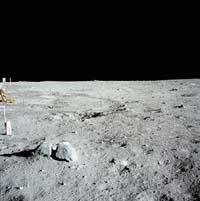
(Photo: Recent searches
A third theory argues that both emerged simultaneously in the same region of space or very close, but did not come together [10]. This theory avoids this unlikely event of random capture, but does not explain why they have such different compositions. If both are born together and in the same region of space, they should have similar compositions.
The fourth theory that is being imposed today is a combination of the previous ones, that is, a protoplanet (Theia) of similar size to Mars suffered a violent clash with the protolor 4.500 million years ago [11]. This terrible shock left a lot of waste around the Earth that for millions of years were condensing into the Moon. This may explain why the mass of the Moon is so large with respect to the Earth, why it has such an inclined orbit with respect to the equator and less inclined with respect to the ecliptic, why it has such a different composition and why it has an age similar to that of the Earth. However, the conditions of such a shock must be very concrete and special (masses, speeds and angles of the two planets), and if they are not exactly fulfilled until the last detail, the consequences of the collision are very different: the two bodies can be stuck, glued one part and the other can escape or attract, but can escape without shocks.
In calculations it is not difficult to establish pre-shock conditions to achieve the desired effects. Thus, mathematical models can simulate and reproduce almost any event. But how likely are all these conditions to occur at once?
The truth is that there are still many mysteries around the Moon.
References:
[1] Barandiaran, M. and Irazabalbeitia, I.
"Small step for a man...", Elhuyar Zientzia eta Teknika, 11/01/1989. Related links
[2] Susaeta, T.
"Marea gora, marea behera", Elhuyar Zientzia eta Teknika, 01/02/1999. Related links
[3] "Tidal locking", Wikipedia, the free encyclopedia. http://en.wikipedia.org/wiki/Tidal_locking
[4] Ocean Tides and the Earth's Rotation, IERS Special Bureau for Tides http://bowie.gsfc.nasa.gov/gfc/tides/intro.html
[5] Trefil, J.S.
A scientist by the sea, Editorial Planeta, 1989. Chapter 5, "The Other Face of the Moon," pp. 66-80.
[6] Measuring the Moon's Distance, Apollo Laser Ranging Experiments Yield Results, LPI Bulletin, 72. August 1994 http://sunearth.gsfc.nasa.gov/eclipse/SEhelp/ApolloLaser.html
[7] Gladman, B. et al.,
"Synchronous Locking of Tidally Evolving Satellites", Icarus 122: 166, (1996), pp. 166-192.
[8] Binder, S.A.
"On the origin of the moon by rotational fission", The Moon, Vol. 11, September-October 1974, pp. 53-76.
[9] United States Mitler
"Formation of an iron-poor moon by partial capture, or: Yet another exotic theory of lunar origin", Icarus, vol. 24, February 1975, pp. 256-268.
[10] Stevenson, D.J.
"Origin of the moon - The collision hypothesis", Annual review of earth and planetary sciences, vol. 15 (A88-18742 06-91), 1987, pp. 271-315.
[11] Canup, R.; Asphaug, E.,
"Origin of the Moon in a giant impact near the end of the Earth's formation",
Nature 412 (2001): 708-712.
Azkargorta Aretxabala, Jon
Services
241
2008
Security
037
Awards; Astronomy
Dossier
Services












